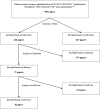The Big Picture of Glioblastoma Malignancy: A Meta-Analysis of Glioblastoma Proteomics to Identify Altered Biological Pathways
- PMID: 34604635
- PMCID: PMC8482494
- DOI: 10.1021/acsomega.1c02991
The Big Picture of Glioblastoma Malignancy: A Meta-Analysis of Glioblastoma Proteomics to Identify Altered Biological Pathways
Abstract
Glioblastoma is a highly malignant cancer with no effective treatment. It is vital to elucidate the mechanisms which drive glioblastoma in order to identify therapeutic targets. The differences in protein expression between glioblastoma, grade I-III glioma, and normal brain tissue reflect the functional alterations driving malignancy. However, proteomic analysis of glioblastoma has been hampered by the heterogeneity of glioblastoma and the variety of methodology used in its study. To reduce these inconsistencies, we performed a meta-analysis of the literature published since 2015, including 14 datasets from eight papers comparing the whole proteome of glioblastoma to normal brain or grade I-III glioma. We found that 154 proteins were commonly upregulated and 116 proteins were commonly downregulated in glioblastoma compared to normal brain. Meanwhile, 240 proteins were commonly upregulated and 125 proteins were commonly downregulated in glioblastoma compared to grade I-III glioma. Functional enrichment analysis revealed upregulation of proteins involved in mRNA splicing and the immune system and downregulation of proteins involved in synaptic signaling and glucose and glutamine metabolism. The identification of these altered biological pathways provides a basis for deeper investigation in the pursuit of an effective treatment for glioblastoma.
© 2021 The Authors. Published by American Chemical Society.
Conflict of interest statement
The authors declare no competing financial interest.
Figures





Similar articles
-
Tissue Proteome Analysis of Different Grades of Human Gliomas Provides Major Cues for Glioma Pathogenesis.OMICS. 2017 May;21(5):275-284. doi: 10.1089/omi.2017.0028. OMICS. 2017. PMID: 28481733
-
Label-free quantitative proteomics unravels the importance of RNA processing in glioma malignancy.Neuroscience. 2017 May 20;351:84-95. doi: 10.1016/j.neuroscience.2017.03.023. Epub 2017 Mar 21. Neuroscience. 2017. PMID: 28341197
-
Investigation of serum proteome alterations in human glioblastoma multiforme.Proteomics. 2012 Aug;12(14):2378-90. doi: 10.1002/pmic.201200002. Proteomics. 2012. PMID: 22684992
-
The Multifaceted Metabolism of Glioblastoma.Adv Exp Med Biol. 2018;1063:59-72. doi: 10.1007/978-3-319-77736-8_4. Adv Exp Med Biol. 2018. PMID: 29946775 Review.
-
Pathway analysis of glutamate-mediated, calcium-related signaling in glioma progression.Biochem Pharmacol. 2020 Jun;176:113814. doi: 10.1016/j.bcp.2020.113814. Epub 2020 Jan 16. Biochem Pharmacol. 2020. PMID: 31954716 Free PMC article. Review.
Cited by
-
Proteomics Studies on Extracellular Vesicles Derived from Glioblastoma: Where Do We Stand?Int J Mol Sci. 2024 Sep 10;25(18):9778. doi: 10.3390/ijms25189778. Int J Mol Sci. 2024. PMID: 39337267 Free PMC article. Review.
-
Glioblastoma survival is associated with distinct proteomic alteration signatures post chemoirradiation in a large-scale proteomic panel.Front Oncol. 2023 Aug 10;13:1127645. doi: 10.3389/fonc.2023.1127645. eCollection 2023. Front Oncol. 2023. PMID: 37637066 Free PMC article.
-
Transcriptome Analysis of Human Glioblastoma Cells Susceptible to Infection with the Leningrad-16 Vaccine Strain of Measles Virus.Viruses. 2022 Nov 2;14(11):2433. doi: 10.3390/v14112433. Viruses. 2022. PMID: 36366531 Free PMC article.
-
Preclinical and Clinical Applications of Metabolomics and Proteomics in Glioblastoma Research.Int J Mol Sci. 2022 Dec 25;24(1):348. doi: 10.3390/ijms24010348. Int J Mol Sci. 2022. PMID: 36613792 Free PMC article. Review.
-
Bioenergetic Profiling in Glioblastoma Multiforme Patients with Different Clinical Outcomes.Metabolites. 2023 Feb 28;13(3):362. doi: 10.3390/metabo13030362. Metabolites. 2023. PMID: 36984801 Free PMC article.
References
-
- Verhaak R. G. W.; Hoadley K. A.; Purdom E.; Wang V.; Qi Y.; Wilkerson M. D.; Miller C. R.; Ding L.; Golub T.; Mesirov J. P.; Alexe G.; Lawrence M.; O’Kelly M.; Tamayo P.; Weir B. A.; Gabriel S.; Winckler W.; Gupta S.; Jakkula L.; Feiler H. S.; Hodgson J. G.; James C. D.; Sarkaria J. N.; Brennan C.; Kahn A.; Spellman P. T.; Wilson R. K.; Speed T. P.; Gray J. W.; Meyerson M.; Getz G.; Perou C. M.; Hayes D. N. Integrated Genomic Analysis Identifies Clinically Relevant Subtypes of Glioblastoma Characterized by Abnormalities in PDGFRA, IDH1, EGFR, and NF1. Cancer Cell 2010, 17, 98–110. 10.1016/j.ccr.2009.12.020. - DOI - PMC - PubMed
-
- Wang Q.; Hu B.; Hu X.; Kim H.; Squatrito M.; Scarpace L.; deCarvalho A. C.; Lyu S.; Li P.; Li Y.; Barthel F.; Cho H. J.; Lin Y.-H.; Satani N.; Martinez-Ledesma E.; Zheng S.; Chang E.; Sauvé C.-E. G.; Olar A.; Lan Z. D.; Finocchiaro G.; Phillips J. J.; Berger M. S.; Gabrusiewicz K. R.; Wang G.; Eskilsson E.; Hu J.; Mikkelsen T.; DePinho R. A.; Muller F.; Heimberger A. B.; Sulman E. P.; Nam D.-H.; Verhaak R. G. W. Tumor Evolution of Glioma-Intrinsic Gene Expression Subtypes Associates with Immunological Changes in the Microenvironment. Cancer Cell 2017, 32, 42–56. 10.1016/j.ccell.2017.06.003. - DOI - PMC - PubMed
LinkOut - more resources
Full Text Sources

